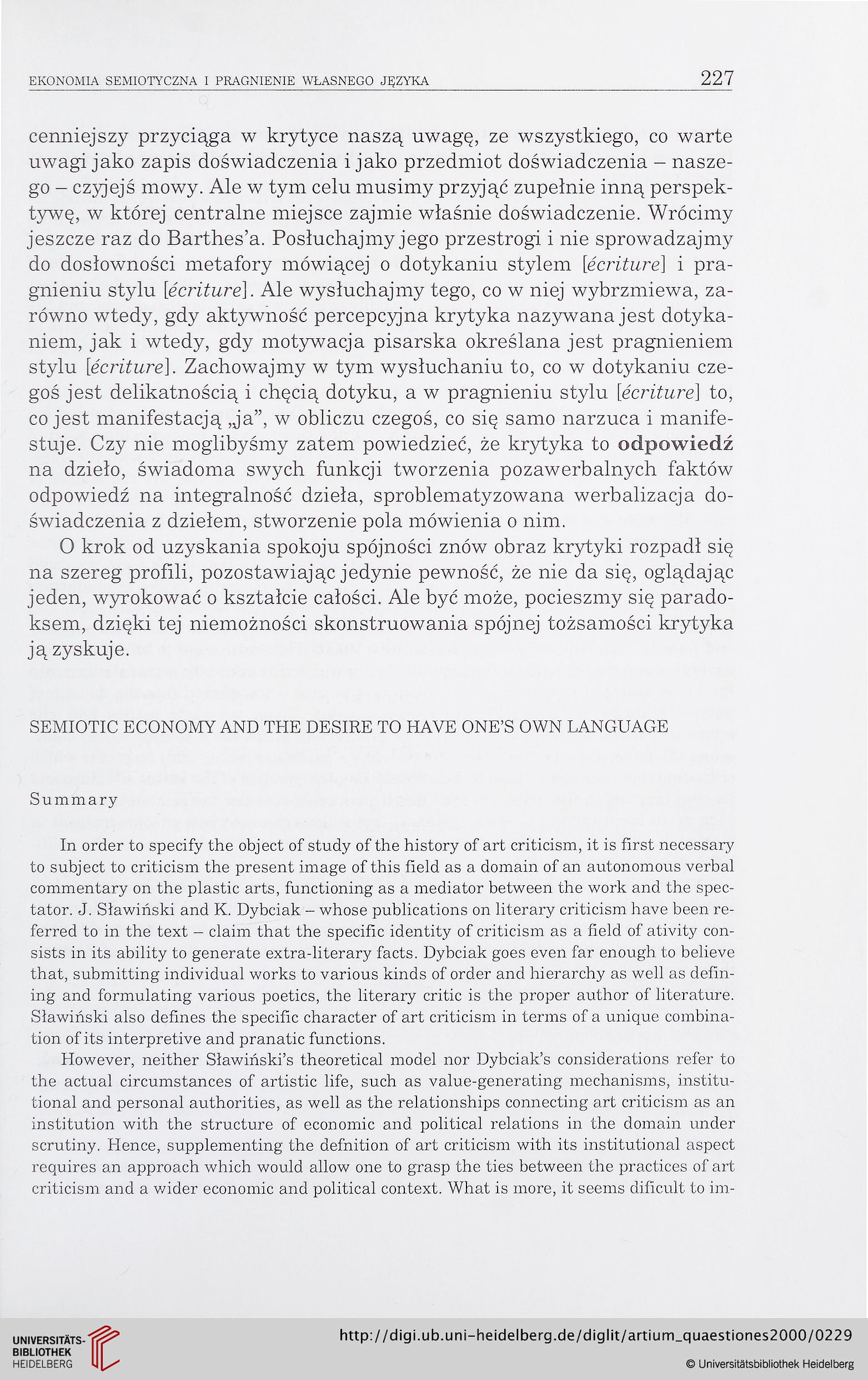EKONOMIA SEMIOTYC2NA I PRAGNIENIE WLASNEGO JÇZYKA
227
cenniejszy przycigga w krytyce naszg uwagç, ze wszystkiego, co warte
uwagi jako zapis doswiadczenia i jako przedmiot doswiadczenia - nasze-
go - czyjejs mowy. Ale w tym celu musimy przyjgc zupeinie inng perspek-
tywç, w ktôrej centralne miejsce zajmie wlasnie doswiadczenie. Wrôcimy
jeszcze raz do Barthes’a. Posluchajmy jego przestrogi i nie sprowadzajmy
do doslownosci metafory môwigcej o dotykaniu stylem [écriture] i pra-
gnieniu stylu [écriture]. Ale wysluchajmy tego, co w niej wybrzmiewa, za-
rowno wtedy, gdy aktywnosc percepcyjna krytyka nazywana jest dotyka-
niem, jak i wtedy, gdy motywacja pisarska okreslana jest pragnieniem
stylu [écriture], Zachowajmy w tym wysluchaniu to, co w dotykaniu cze-
gos jest delikatnoscig i chçcig dotyku, a w pragnieniu stylu [écriture] to,
co jest manifestacjg ,ja”, w obliczu czegos, co siç samo narzuca i manife-
stuje. Czy nie moglibysmy zatem powiedziec, ze krytyka to odpowiedz
na dzielo, swiadoma swych funkcji tworzenia pozawerbalnych faktôw
odpowiedz na integralnosc dzieia, sproblematyzowana werbalizacja do-
swiadczenia z dzielem, stworzenie pola môwienia o nim.
O krok od uzyskania spokoju spôjnosci znôw obraz krytyki rozpadl siç
na szereg profili, pozostawiajgc jedynie pewnosc, ze nie da siç, oglgdajgc
jeden, wyrokowac o ksztalcie calosci. Ale byc moze, pocieszmy siç parado-
ksem, dzi^ki tej niemoznosci skonstruowania spôjnej tozsamosci krytyka
j^zyskuje.
SEMIOTIC ECONOMY AND THE DESIRE TO HAVE ONE’S OWN LANGUAGE
Summary
In order to specify the object of study of the history of art criticism, it is first necessary
to subject to criticism the présent image of this fïeld as a domain of an autonomous verbal
commentary on the plastic arts, functioning as a mediator between the work and the spec-
tator. J. Slawinski and K. Dybciak - whose publications on literary criticism hâve been re-
ferred to in the text - claim that the spécifie identity of criticism as a field of ativity con-
sists in its ability to generate extra-literary facts. Dybciak goes even far enough to believe
that, submitting individual works to various kinds of order and hierarchy as well as defïn-
ing and formulating various poetics, the literary critic is the proper author of literature.
Slawinski also defines the spécifie character of art criticism in terms of a unique combina-
tion of its interpretive and pranatic functions.
However, neither Slawinski’s theoretical model nor Dybciak’s considérations refer to
the actual circumstances of artistic life, such as value-generating mechanisms, institu-
tional and personal authorities, as well as the relationships connecting art criticism as an
institution with the structure of économie and political relations in the domain under
scrutiny. Hence, supplementing the defnition of art criticism with its institutional aspect
requires an approach which would allow one to grasp the ties between the practices of art
criticism and a wider économie and political context. What is more, it seems dificult to im-
227
cenniejszy przycigga w krytyce naszg uwagç, ze wszystkiego, co warte
uwagi jako zapis doswiadczenia i jako przedmiot doswiadczenia - nasze-
go - czyjejs mowy. Ale w tym celu musimy przyjgc zupeinie inng perspek-
tywç, w ktôrej centralne miejsce zajmie wlasnie doswiadczenie. Wrôcimy
jeszcze raz do Barthes’a. Posluchajmy jego przestrogi i nie sprowadzajmy
do doslownosci metafory môwigcej o dotykaniu stylem [écriture] i pra-
gnieniu stylu [écriture]. Ale wysluchajmy tego, co w niej wybrzmiewa, za-
rowno wtedy, gdy aktywnosc percepcyjna krytyka nazywana jest dotyka-
niem, jak i wtedy, gdy motywacja pisarska okreslana jest pragnieniem
stylu [écriture], Zachowajmy w tym wysluchaniu to, co w dotykaniu cze-
gos jest delikatnoscig i chçcig dotyku, a w pragnieniu stylu [écriture] to,
co jest manifestacjg ,ja”, w obliczu czegos, co siç samo narzuca i manife-
stuje. Czy nie moglibysmy zatem powiedziec, ze krytyka to odpowiedz
na dzielo, swiadoma swych funkcji tworzenia pozawerbalnych faktôw
odpowiedz na integralnosc dzieia, sproblematyzowana werbalizacja do-
swiadczenia z dzielem, stworzenie pola môwienia o nim.
O krok od uzyskania spokoju spôjnosci znôw obraz krytyki rozpadl siç
na szereg profili, pozostawiajgc jedynie pewnosc, ze nie da siç, oglgdajgc
jeden, wyrokowac o ksztalcie calosci. Ale byc moze, pocieszmy siç parado-
ksem, dzi^ki tej niemoznosci skonstruowania spôjnej tozsamosci krytyka
j^zyskuje.
SEMIOTIC ECONOMY AND THE DESIRE TO HAVE ONE’S OWN LANGUAGE
Summary
In order to specify the object of study of the history of art criticism, it is first necessary
to subject to criticism the présent image of this fïeld as a domain of an autonomous verbal
commentary on the plastic arts, functioning as a mediator between the work and the spec-
tator. J. Slawinski and K. Dybciak - whose publications on literary criticism hâve been re-
ferred to in the text - claim that the spécifie identity of criticism as a field of ativity con-
sists in its ability to generate extra-literary facts. Dybciak goes even far enough to believe
that, submitting individual works to various kinds of order and hierarchy as well as defïn-
ing and formulating various poetics, the literary critic is the proper author of literature.
Slawinski also defines the spécifie character of art criticism in terms of a unique combina-
tion of its interpretive and pranatic functions.
However, neither Slawinski’s theoretical model nor Dybciak’s considérations refer to
the actual circumstances of artistic life, such as value-generating mechanisms, institu-
tional and personal authorities, as well as the relationships connecting art criticism as an
institution with the structure of économie and political relations in the domain under
scrutiny. Hence, supplementing the defnition of art criticism with its institutional aspect
requires an approach which would allow one to grasp the ties between the practices of art
criticism and a wider économie and political context. What is more, it seems dificult to im-




